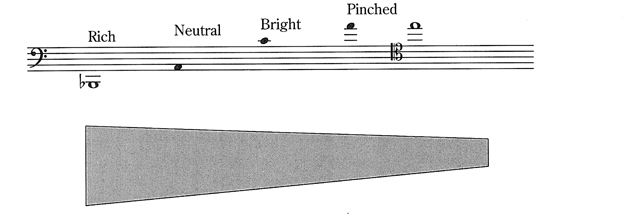Bassoon
IT: fagotto – FR: basson – GER: Fagott
Properties
The bassoon is a double-reed, conical bore instrument most often made of maple wood, although plastic and hard rubber are also used. The pipe is bent double, and the reed is attached to a tube called the bocal, which curves away from the instrument. The instrument provides a bass or tenor voice for the woodwind choir.
Range and Natural Dynamics


FIGURE 3.13 Bassoon range
Transposition
The bassoon sounds as written. The compass is from B♭ upwards approximately three and a half octaves. As in all double reeds, the dynamics are strong in the low extremes of the range and progressively weaker in the upper registers. The bass clef is used for passages in the low and middle parts of the range; the tenor clef is used for passages in the highest part.
Tone Quality
The bassoon’s timbre is much less nasal than that of the oboe, but it has the capacity to produce similar articulations. The lowest register is dark and rich in overtones, and very soft notes with delicate attacks are difficult to produce in this range. The middle range is transparent, blending well with other instruments, and is very expressive. The upper register, which makes a unique solo voice, does not penetrate through a heavy texture. In the hands of an accomplished player, the entire range is quite even and suitable for unobtrusive accompanimental parts or solos with a light background.
Technical Abilities
Except in extreme low and high ranges, the bassoon is agile. Wide leaps and rapid tonguing are idiomatic. In writing for the bassoon, orchestrators should provide ample rests in very loud or very low passages. Notes are usually single-tongued, but all other tonguings are possible. Some trills (major or minor second) are problematic in extreme high and low registers, as are rapid repeated notes in the lowest part of the range.
Musical Example


FIGURE 3.14 Bassoon line: Beethoven, Symphony No.5, second movement, measures 205-213
Contrabassoon
The contrabassoon sounds an octave lower than the bassoon and is slightly less agile. Its practical range is approximately two and a half octaves upwards from the low BB♭, and the highest part of the range is seldom used. The powerful, incisive sound is useful in dense textures to strengthen the bass line.
Obsolete members of the bassoon family include the tenoroon, the quartfagott, and the quintfagott.
